|
OH 14 |
3729 |
27 - MNK |
287 - 88 "Skull Site" |
CRA-f
, FRO-f
, R-PAR-f |
1963 |
122 - National Museum and House of Culture, Dar es Salaam, Tanzania |
II |
Lower Middle B |
Surface. Inferred as same horizon as OH 13 (Leakey MD, 1971). |
Leakey, L.S.B., Tobias, P.V. & Napier, J.R. 1964. A new species of the genus Homo from Olduvai Gorge. Nature 202(4927): 7-9. |
Juvenile (sutures unfused). Thin skull. Specimen previously housed at National Museum of Kenya. 11 pieces found at House of Culture, Dar es Salaam, Tanzania. |
130 - L.S.B. Leakey |
|
264 - Leakey family expedition |
No |
|
Mammalia |
Primates |
Anthropoidea |
Haplorhini |
Hominoidea |
Hominidae |
|
|
|
|
|
Juvenile, parietal is thin. |
No |
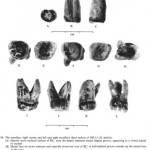 |
OH 15 |
3730 |
27 - MNK |
287 - 88 "Skull Site" |
C
, M |
1963 |
122 - National Museum and House of Culture, Dar es Salaam, Tanzania |
II |
Lower Middle |
Above level of OH 13. |
Leakey MD. (1971) Olduvai Gorge, Vol. 3: excavations in Beds I & II 1960-1963. New York, NY: Cambridge University Press. |
One canine, two molars. Canine is worn, molars are upper molars. "The teeth are exceedingly robust and show an unusual degree of wear. They were not found in close association; one molar and the canine lay approximately I ft. "Qelow the top of the tuff in which they occurred, whilst the second molar was 4 ft. distant and 1 ft. deeper in the deposit" (Leakey MD, 1971:232). Specimen previously housed at National Museum of Kenya. 7 pieces found at House of Culture, Dar es Salaam, Tanzania. |
154 - Leakey and Leakey |
|
264 - Leakey family expedition |
Yes |
|
Mammalia |
Primates |
Anthropoidea |
Haplorhini |
Hominoidea |
Hominidae |
Homininae |
Hominini |
Homo |
|
|
|
No |
|
OH 12 |
3727 |
18 - VEK |
286 - 86 |
OCC
, L/R-PAR
, L/R-TEM-f
, CRA-f
, L-PAL
, L-MAX
, TOOTH-f |
1962 |
122 - National Museum and House of Culture, Dar es Salaam, Tanzania |
IV? |
a |
Surface. Found on eroded slope of Bed III. L-TEM-f from just below marker Tuff IVa. |
Leakey, L., and Leakey, M. 1964. Recent discoveries of fossil hominids in tanganyika: at Olduvai and near Lake Natron. Nature 202:5-7. |
Crowns of teeth not preserved. Bed IVA determined on basis of matrix adhering to L-TEM-f and PAL. Specimen previously housed at National Museum of Kenya. |
|
|
264 - Leakey family expedition |
No |
L-TEM-f & PAL found with matrix adhering. |
Mammalia |
Primates |
Anthropoidea |
Haplorhini |
Hominoidea |
Hominidae |
Homininae |
Hominini |
Homo |
erectus |
|
|
No |
|
OH 11 |
3726 |
24 - DK |
285 - 13 |
PAL
, L-MAX-f
, TOOTH-f |
1962 |
122 - National Museum and House of Culture, Dar es Salaam, Tanzania |
Ndutu |
Lower |
Found in stream bed at bottom of gully near DK excavations. See curatorial notes for details. |
Leakey MD. (1971) Olduvai Gorge, Vol. 3: excavations in Beds I & II 1960-1963. New York, NY: Cambridge University Press. |
Left half of palate and maxillary arch, crowns of teeth not preserved. "It is thus impossible to assign to any stratigraphic level, although the condition of the bone, which bears a pinkish tinge, is similar to that seen in fossil bones from a conglomerate at the head of the DK gully belonging to the lower Ndutu Beds" (Leakey MD, 1971:230). Specimen previously housed at National Museum of Kenya. |
154 - Leakey and Leakey |
|
264 - Leakey family expedition |
No |
|
Mammalia |
Primates |
Anthropoidea |
Haplorhini |
Hominoidea |
Hominidae |
Homininae |
Hominini |
Homo |
sp. |
|
|
No |
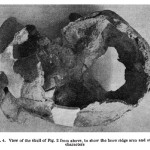 |
OH 9 |
3724 |
71 - LLK |
284 - 46 |
CALV |
2 December 1960 |
122 - National Museum and House of Culture, Dar es Salaam, Tanzania |
II |
Upper II D |
Surface |
Leakey LSB. 1966. Homo habilis, Homo erectus and the Australopithecines. Nature, 209(5030), 1279–1281. |
Calvaria. "Chellean Man." |
|
|
264 - Leakey family expedition |
No |
Yes. |
Mammalia |
Primates |
Anthropoidea |
Haplorhini |
Hominoidea |
Hominidae |
Homininae |
Hominini |
Homo |
erectus |
|
|
No |
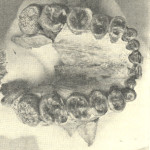 |
OH 5 |
3713 |
5 - FLK |
283 - 45 |
CRA
, MAX
, M
, I
, C
, P |
17 July - 6 August 1959 |
122 - National Museum and House of Culture, Dar es Salaam, Tanzania |
I |
Middle (Zinj.) |
22 feet below the upper limit of Bed I (Tuff IF), approximately 20 feet above basalt. |
Leakey, L. S. B. 1959. A new fossil skull from Olduvai. Nature 184:491-493. |
Holotype. Almost complete cranium. Adolescent. One reconstructed fossil found at House of Culture, Dar es Salaam, Tanzania. Specimen previously housed at National Museum of Kenya. Additional pieces from NMK unpublished. |
142 - M. D. Leakey |
|
264 - Leakey family expedition |
Yes |
|
Mammalia |
Primates |
Anthropoidea |
Haplorhini |
Hominoidea |
Hominidae |
|
|
Zinjanthropus |
boisei |
|
Holotype. This specimen was reclassified as Paranthropus boisei by Robinson (1960). |
No |
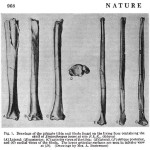 |
OH 6 |
3721 |
5 - FLK |
283 - 45 |
CRA-f
, M-f
, L-P
, L-TIB-f
, L-FIB-f
, |
1959/60 |
122 - National Museum and House of Culture, Dar es Salaam, Tanzania |
I |
Middle (Zinj.) |
Surface. Cranial and dental fragments found in surface soil from slope immediately below Zinj. site; assumed to be from Zinj. level (Leakey, MD, 1971:227). TIB-f and FIB-f from Zinj. level. |
Davis, P. R. 1964. Hominid fossils from Bed I, Olduvai Gorge, Tanganyika. A tibia and fibula. Nature. 201, 967. |
From Tobias (1991): OH 35 tibia and fibula attributed to same individual as OH 6 but appear to be more mature. It is unclear if OH 35 tibia and fibula are the same tibia and fibula originally listed under OH 6. Leakey, MD, 1971 describes CRA and dental fragments as having been found in surface soil, but Leakey, Tobias, and Napier, 1964 state "some [were] found in situ [and] some on the surface" (:9). Unworn lower L-P3. Partially developed roots of upper M1 or 2. Six cranial vault fragments. Tibia and fibula fragments first assumed to be associated with Zinjanthropus OH5, but should be considered associates with OH 6 following morphological study (Leakey, MD, 1971:227). and skull fragments. Juvenile. Specimen previously housed at National Museum of Kenya. |
|
|
264 - Leakey family expedition |
Unknown |
|
Mammalia |
Primates |
Anthropoidea |
Haplorhini |
Hominoidea |
Hominidae |
Homininae |
Hominini |
Homo |
habilis |
|
Paratype. TIB-f and FIB-f not given taxonomic designation in original publication (Davis, 1964) but named as a paratype in Leakey, Tobias, and Napier, 1964. |
No |
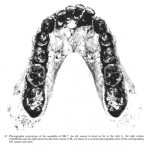 |
OH 7 |
3722 |
6 - FLK NN |
283 - 45 |
MAN
, L-PAR
, R-PAR-f
, M
, OCC-f
, L/R-TEM-f
, PHX
, CAR |
1960 |
122 - National Museum and House of Culture, Dar es Salaam, Tanzania |
I |
3 |
On surface of clay immediately overlying Tuff IB. |
Leakey, L.S.B., Tobias, P.V. & Napier, J.R. 1964. A new species of the genus Homo from Olduvai Gorge. Nature 202(4927): 7-9. |
Holotype. "Jonny's Child". Juvenile. Mandible with partial dentition and unerupted R/L-M3, almost complete left parietal and fragments of right parietal, left and right petrous portions (temporal) , "sundry small skull fragments ... [and] twenty-one bones of the hand, including the trapezium, scaphoid and a number of phalanges" (Leakey, MD, 1971:228). "One upper molar, a terminal phalanx, and a broken capitate bone, found on the surface, probably also belong to this individual" (:226). Specimen previously housed at National Museum of Kenya. |
|
|
264 - Leakey family expedition |
Yes |
|
Mammalia |
Primates |
Anthropoidea |
Haplorhini |
Hominoidea |
Hominidae |
Homininae |
Hominini |
Homo |
habilis |
|
Holotype |
No |
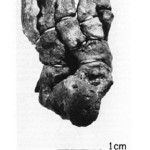 |
OH 8 |
3723 |
6 - FLK NN |
283 - 45 |
PHX
, CAR
, TAR
, CLA
, AST
, CAL
, CUNE
, CUB
, NAV
, M-f |
1960 |
122 - National Museum and House of Culture, Dar es Salaam, Tanzania |
I |
3 |
|
Leakey MD. (1971) Olduvai Gorge, Vol. 3: excavations in Beds I & II 1960-1963. New York, NY: Cambridge University Press. |
The molar-f was found on the surface and "probably also belongs to OH 8" (Leakey MD, 1971:228). Twelve associated foot bones including astragalus (has carnivore tooth marks (Leakey MD, 1971), calcaneus, cuboid and navicular, cuneiforms 1- 3, proximal ends with shafts, five metatarsals. Proximal ends of one metacarpal and three finger phalanges. One radius shaft. Clavicle with damaged articular ends. Foot articulates "almost perfectly with the OH 35 leg" (Susman, 1983:372). |
130 - L.S.B. Leakey |
|
264 - Leakey family expedition |
Yes |
|
Mammalia |
Primates |
Anthropoidea |
Haplorhini |
Hominoidea |
Hominidae |
Homininae |
Hominini |
Homo |
habilis |
|
Paratype |
No |
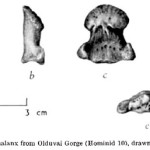 |
OH 10 |
3725 |
7 - FLK North |
283 - 45 |
R-PHX |
1961 |
122 - National Museum and House of Culture, Dar es Salaam, Tanzania |
I |
Upper (level 5) |
3.5 feet below marker Tuff IF at top of Bed I |
Leakey MD. (1971) Olduvai Gorge, Vol. 3: excavations in Beds I & II 1960-1963. New York, NY: Cambridge University Press. |
Terminal first phalanx. Specimen previously housed at National Museum of Kenya. |
154 - Leakey and Leakey |
|
264 - Leakey family expedition |
Yes |
|
Mammalia |
Primates |
Anthropoidea |
Haplorhini |
Hominoidea |
Hominidae |
Homininae |
Hominini |
|
|
|
|
No |
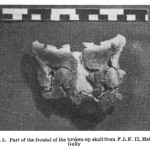 |
OH 16 |
3731 |
72 - FLK Maiko Gully |
283 - 45 |
CRA-f
, TOOTH
, MAN
, |
1963 |
122 - National Museum and House of Culture, Dar es Salaam, Tanzania |
II |
base |
| Leakey MD. (1971) Olduvai Gorge, Vol. 3: excavations in Beds I & II 1960-1963. New York, NY: Cambridge University Press. |
Upper and lower dentition, calotte, and > 1500 unidentified fragments due to cattle trampling. Majority of fragments found on surface of Tuff IF, some teeth found in situ, 2 feet above Tuff IF. Specimen previously housed at National Museum of Kenya. |
154 - Leakey and Leakey |
|
264 - Leakey family expedition |
No |
|
Mammalia |
Primates |
Anthropoidea |
Haplorhini |
Hominoidea |
Hominidae |
Homininae |
Hominini |
Homo |
habilis |
|
Leakey LSB, 1964 refers to this specimen as Homo erectus. Leakey, Tobias, and Napier provisionally assign it to Homo habilis (referred material, not paratype) (1964), and Leakey MD, 1971 refers to it as cf. Australopithecus. |
Yes |
|
OH 18 |
3733 |
55 - FLK W |
283 - 45 |
PHX |
1969 |
104 - Unknown |
II |
Middle- 10 feet above base of Bed II, below Tuff IIC |
Surface |
Leakey MD. (1971) Olduvai Gorge, Vol. 3: excavations in Beds I & II 1960-1963. New York, NY: Cambridge University Press. |
Phalanx of the hand. |
|
|
264 - Leakey family expedition |
No |
|
Mammalia |
Primates |
Anthropoidea |
Haplorhini |
Hominoidea |
Hominidae |
|
|
|
|
|
|
No |
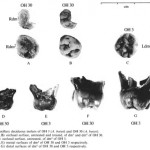 |
OH 30 |
3745 |
72 - FLK Maiko Gully |
283 - 45 |
TOOTH
, d-TOOTH
, CRA-f
, |
1969 |
122 - National Museum and House of Culture, Dar es Salaam, Tanzania |
II |
Lower |
Surface |
|
"Parts deciduous and germ dentitions" (Leakey MD, 1971:234). Specimen previously housed at National Museum of Kenya. |
|
|
264 - Leakey family expedition |
No |
|
Mammalia |
Primates |
Anthropoidea |
Haplorhini |
Hominoidea |
Hominidae |
|
|
Australopithecus |
boisei |
|
|
No |
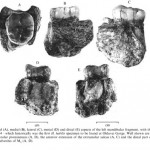 |
OH 4 |
3720 |
8 - MK |
281 - 11 |
P
, M
, MAN |
1959 |
122 - National Museum and House of Culture, Dar es Salaam, Tanzania |
I |
Lower |
Surface. |
Leakey, L.S.B., Tobias, P.V. & Napier, J.R. 1964. A new species of the genus Homo from Olduvai Gorge. Nature 202(4927): 7-9. |
Paratype. Two isolated teeth (lower molar and upper premolar) and one M3 in a mandible. Found in small block of consolidated tuff. �Specimen previously housed at National Museum of Kenya. |
282 - H. Mukiri |
|
264 - Leakey family expedition |
Yes |
|
Mammalia |
Primates |
Anthropoidea |
Haplorhini |
Hominoidea |
Hominidae |
Homininae |
Hominini |
Homo |
habilis |
|
Paratype |
No |
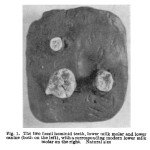 |
OH 3 |
3719 |
10 - BK |
280 - 94 |
d-C
, L-d-M |
1955 |
122 - National Museum and House of Culture, Dar es Salaam, Tanzania |
II |
Upper |
Upper part of BK channel which cuts into Tuff IID |
Leakey MD. (1971) Olduvai Gorge, Vol. 3: excavations in Beds I & II 1960-1963. New York, NY: Cambridge University Press. |
In the first publication of these specimens (Leakey, LSB, 1958), Leakey described the teeth as a deciduous lower canine and a left deciduous upper M2. "This view was not shared by Robinson, von Koenigswald and others, who preferred to regard it as either a permanent or a deciduous upper molar of an australopithecine character" (Leakey, MD, 1970:226). Specimen previously housed at National Museum of Kenya. |
130 - L.S.B. Leakey |
|
264 - Leakey family expedition |
Yes |
|
Mammalia |
Primates |
Anthropoidea |
Haplorhini |
Hominoidea |
Hominidae |
|
|
Australopithecus |
|
|
Referred to as species boisei in Tobias (Olduvai Gorge volume IV, 1991). |
No |
|
OH 2 |
3718 |
27 - MNK |
279 - 88 |
CRA-f |
1935 |
106 - Natural History Museum UK (?) |
III/IV |
Lowest horizon of Bed IVa. |
Surface. Found at head of MNK Gully where Beds II and IV are exposed. |
Leakey MD. (1971) Olduvai Gorge, Vol. 3: excavations in Beds I & II 1960-1963. New York, NY: Cambridge University Press. |
Two cranial vault fragments. Specimen previously housed at National Museum of Kenya. Not found at House of Culture, Dar es Salaam, Tanzania. |
142 - M. D. Leakey |
|
264 - Leakey family expedition |
No |
|
Mammalia |
Primates |
Anthropoidea |
Haplorhini |
Hominoidea |
Hominidae |
Homininae |
Hominini |
Homo |
erectus |
|
Similar to OH 9 and OH 12. |
No |
|
OH 1 |
3717 |
13 - RK |
278 - 9 |
SKEL |
1913 |
116 - Bayerische Staatssammlung für Paläontologie und Geologie (BSPG), Munich, Germany |
Ndutu |
Intrusive burial |
|
Hans-Reck. 1913, Oldoway-Expedition Monograph; LSB Leakey 18 March 1933 |
Partial skeleton. Intrusive burial post-dating primary Olduvai sequence. |
144 - H. Reck |
|
273 - Reck expedition |
Unknown |
|
Mammalia |
Primates |
Anthropoidea |
Haplorhini |
Hominoidea |
Hominidae |
Homininae |
Hominini |
Homo |
sapiens |
|
|
No |
|
OH 25 |
3740 |
|
268 - 54 |
L-PAR-f |
1968 |
122 - National Museum and House of Culture, Dar es Salaam, Tanzania |
IV |
a |
Surface |
Leakey MD. (1971) Olduvai Gorge, Vol. 3: excavations in Beds I & II 1960-1963. New York, NY: Cambridge University Press. |
Left parietal fragment ca. asterion. Specimen previously housed at National Museum of Kenya. |
142 - M. D. Leakey |
|
264 - Leakey family expedition |
No |
|
Mammalia |
Primates |
Anthropoidea |
Haplorhini |
Hominoidea |
Hominidae |
|
|
|
|
|
Juvenile. |
No |
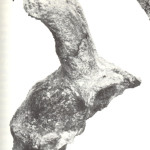 |
S. 38 |
1069 |
|
268 - 54 |
CRA
, L/R-HOR |
1968 |
104 - Unknown |
II |
|
Above the Lemuta Member |
Gentry, A. W., and Gentry, A. 1978. Fossil Bovidae (Mammalia) of Olduvai Gorge, Tanzania. Part I. Bulletin of the British Museum (Natural History): Geology 29:289-446. |
This specimen is pictured in plate 25, figure 1. |
137 - A. Gentry |
|
|
Yes |
Agutite and mafic volcanic glass. |
Mammalia |
Artiodactyla |
Ruminantia |
|
Bovoidea |
Bovidae |
Alcelaphinae |
Alcelaphini |
Damaliscus |
agelaius |
|
|
No |
 |
COP-12-81 |
9665 |
|
101 - 19A |
R/L-HOR |
|
126 - Mary Leakey Camp, Antiquities Station Olduvai Gorge, Tanzania |
|
|
|
-- |
Right and left horn core. |
157 - L. Hlusko |
2013/06/22 |
254 - COP |
Unknown |
|
Mammalia |
Artiodactyla |
Ruminantia |
|
Bovoidea |
Bovidae |
|
|
|
|
|
|
No |
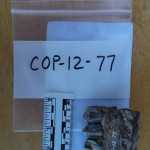 |
COP-12-77 |
9661 |
|
100 - 14 |
R-MAN-f, R-M |
|
126 - Mary Leakey Camp, Antiquities Station Olduvai Gorge, Tanzania |
I |
|
|
-- |
Right mandible fragment with M2 and M3. |
157 - L. Hlusko |
2013/06/22 |
254 - COP |
Unknown |
Y |
Mammalia |
Artiodactyla |
Ruminantia |
|
Bovoidea |
Bovidae |
|
|
|
|
|
|
No |
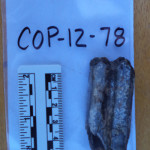 |
COP-12-78 |
9662 |
|
100 - 14 |
M |
|
126 - Mary Leakey Camp, Antiquities Station Olduvai Gorge, Tanzania |
IV |
|
|
-- |
|
157 - L. Hlusko |
2013/06/22 |
254 - COP |
Unknown |
|
Mammalia |
Artiodactyla |
Ruminantia |
|
Bovoidea |
Bovidae |
|
|
|
|
|
|
No |
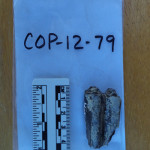 |
COP-12-79 |
9663 |
|
100 - 14 |
M |
|
126 - Mary Leakey Camp, Antiquities Station Olduvai Gorge, Tanzania |
IV |
|
|
-- |
|
157 - L. Hlusko |
2013/06/22 |
254 - COP |
Unknown |
|
Mammalia |
Artiodactyla |
Ruminantia |
|
Bovoidea |
Bovidae |
|
|
|
|
|
|
No |
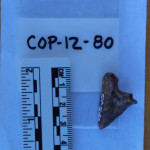 |
COP-12-80 |
9664 |
|
100 - 14 |
PHX |
|
126 - Mary Leakey Camp, Antiquities Station Olduvai Gorge, Tanzania |
IV |
|
|
-- |
Distal phalanx. |
157 - L. Hlusko |
2013/06/22 |
254 - COP |
Unknown |
|
Mammalia |
Artiodactyla |
Ruminantia |
|
Bovoidea |
Bovidae |
|
|
|
|
|
|
No |
|
RMNH2437 |
9455 |
|
|
MTC |
|
129 - National Natural History Museum, Naturalis, Leiden, The Netherlands (RMNH) |
|
|
|
-- |
Third metacarpal. |
159 - R. Bernor |
|
|
Unknown |
|
Mammalia |
Perissodactyla |
Hippomorpha |
|
|
Equidae |
Equinae |
Hipparionini |
Eurygnathohippus |
|
|
Inventoried by Ray Bernor. Identified by Bernor as genus Eurygnathohippus. |
No |
|
RMNH2481 |
9456 |
|
|
MTT |
|
129 - National Natural History Museum, Naturalis, Leiden, The Netherlands (RMNH) |
|
|
|
-- |
Third metatarsal. |
159 - R. Bernor |
|
|
Unknown |
|
Mammalia |
Perissodactyla |
Hippomorpha |
|
|
Equidae |
Equinae |
Hipparionini |
Eurygnathohippus |
|
|
Inventoried by Ray Bernor. Identified by Bernor as genus Eurygnathohippus. |
No |
|
RMNH254 |
9457 |
|
|
RAD |
|
129 - National Natural History Museum, Naturalis, Leiden, The Netherlands (RMNH) |
|
|
|
-- |
|
159 - R. Bernor |
|
|
Unknown |
|
Mammalia |
Perissodactyla |
Hippomorpha |
|
|
Equidae |
Equinae |
Hipparionini |
Eurygnathohippus |
|
|
Inventoried by Ray Bernor. Identified by Bernor as genus Eurygnathohippus. |
No |
|
RMNH2541 |
9458 |
|
|
AST |
|
129 - National Natural History Museum, Naturalis, Leiden, The Netherlands (RMNH) |
|
|
|
-- |
|
159 - R. Bernor |
|
|
Unknown |
|
Mammalia |
Perissodactyla |
Hippomorpha |
|
|
Equidae |
Equinae |
Hipparionini |
Eurygnathohippus |
|
|
Inventoried by Ray Bernor. Identified by Bernor as genus Eurygnathohippus. |
No |
|
RMNH2560 |
9459 |
|
|
MTT |
|
129 - National Natural History Museum, Naturalis, Leiden, The Netherlands (RMNH) |
|
|
|
-- |
Third metatarsal. |
159 - R. Bernor |
|
|
Unknown |
|
Mammalia |
Perissodactyla |
Hippomorpha |
|
|
Equidae |
Equinae |
Hipparionini |
Eurygnathohippus |
|
|
Inventoried by Ray Bernor. Identified by Bernor as genus Eurygnathohippus. |
No |
|
RMNH26 |
9460 |
|
|
AST |
|
129 - National Natural History Museum, Naturalis, Leiden, The Netherlands (RMNH) |
|
|
|
-- |
|
159 - R. Bernor |
|
|
Unknown |
|
Mammalia |
Perissodactyla |
Hippomorpha |
|
|
Equidae |
Equinae |
Hipparionini |
Eurygnathohippus |
|
|
Inventoried by Ray Bernor. Identified by Bernor as genus Eurygnathohippus. |
No |
|
RMNH264 |
9461 |
|
|
FEM |
|
129 - National Natural History Museum, Naturalis, Leiden, The Netherlands (RMNH) |
|
|
|
-- |
|
159 - R. Bernor |
|
|
Unknown |
|
Mammalia |
Perissodactyla |
Hippomorpha |
|
|
Equidae |
Equinae |
Hipparionini |
Eurygnathohippus |
|
|
Inventoried by Ray Bernor. Identified by Bernor as genus Eurygnathohippus. |
No |
|
RMNH268 |
9462 |
|
|
HUM |
|
129 - National Natural History Museum, Naturalis, Leiden, The Netherlands (RMNH) |
|
|
|
-- |
|
159 - R. Bernor |
|
|
Unknown |
|
Mammalia |
Perissodactyla |
Hippomorpha |
|
|
Equidae |
Equinae |
Hipparionini |
Eurygnathohippus |
|
|
Inventoried by Ray Bernor. Identified by Bernor as genus Eurygnathohippus. |
No |
|
RMNH2685 |
9463 |
|
|
HUM |
|
129 - National Natural History Museum, Naturalis, Leiden, The Netherlands (RMNH) |
|
|
|
-- |
|
159 - R. Bernor |
|
|
Unknown |
|
Mammalia |
Perissodactyla |
Hippomorpha |
|
|
Equidae |
Equinae |
Hipparionini |
Eurygnathohippus |
|
|
Inventoried by Ray Bernor. Identified by Bernor as genus Eurygnathohippus. |
No |
|
RMNH275 (1) |
9464 |
|
|
MTC |
|
129 - National Natural History Museum, Naturalis, Leiden, The Netherlands (RMNH) |
|
|
|
-- |
Third metacarpal. |
159 - R. Bernor |
|
|
Unknown |
|
Mammalia |
Perissodactyla |
Hippomorpha |
|
|
Equidae |
Equinae |
Hipparionini |
Eurygnathohippus |
|
|
Inventoried by Ray Bernor. Identified by Bernor as genus Eurygnathohippus. |
No |
|
RMNH275 (2) |
9465 |
|
|
MTT |
|
129 - National Natural History Museum, Naturalis, Leiden, The Netherlands (RMNH) |
|
|
|
-- |
Third metatarsal. |
159 - R. Bernor |
|
|
Unknown |
|
Mammalia |
Perissodactyla |
Hippomorpha |
|
|
Equidae |
Equinae |
Hipparionini |
Eurygnathohippus |
|
|
Inventoried by Ray Bernor. Identified by Bernor as genus Eurygnathohippus. |
No |
|
RMNH2750 |
9466 |
|
|
MTC |
|
129 - National Natural History Museum, Naturalis, Leiden, The Netherlands (RMNH) |
|
|
|
-- |
Third metacarpal. |
159 - R. Bernor |
|
|
Unknown |
|
Mammalia |
Perissodactyla |
Hippomorpha |
|
|
Equidae |
Equinae |
Hipparionini |
Eurygnathohippus |
|
|
Inventoried by Ray Bernor. Identified by Bernor as genus Eurygnathohippus. |
No |
|
RMNH28 |
9467 |
|
|
AST |
|
129 - National Natural History Museum, Naturalis, Leiden, The Netherlands (RMNH) |
|
|
|
-- |
|
159 - R. Bernor |
|
|
Unknown |
|
Mammalia |
Perissodactyla |
Hippomorpha |
|
|
Equidae |
Equinae |
Hipparionini |
Eurygnathohippus |
|
|
Inventoried by Ray Bernor. Identified by Bernor as genus Eurygnathohippus. |
No |
|
RMNH280 |
9468 |
|
|
HUM |
|
129 - National Natural History Museum, Naturalis, Leiden, The Netherlands (RMNH) |
|
|
|
-- |
|
159 - R. Bernor |
|
|
Unknown |
|
Mammalia |
Perissodactyla |
Hippomorpha |
|
|
Equidae |
Equinae |
Hipparionini |
Eurygnathohippus |
|
|
Inventoried by Ray Bernor. Identified by Bernor as genus Eurygnathohippus. |
No |
|
RMNH284 |
9469 |
|
|
HUM |
|
129 - National Natural History Museum, Naturalis, Leiden, The Netherlands (RMNH) |
|
|
|
-- |
|
159 - R. Bernor |
|
|
Unknown |
|
Mammalia |
Perissodactyla |
Hippomorpha |
|
|
Equidae |
Equinae |
Hipparionini |
Eurygnathohippus |
|
|
Inventoried by Ray Bernor. Identified by Bernor as genus Eurygnathohippus. |
No |
|
RMNH294 |
9470 |
|
|
MTT |
|
129 - National Natural History Museum, Naturalis, Leiden, The Netherlands (RMNH) |
|
|
|
-- |
Third metatarsal. |
159 - R. Bernor |
|
|
Unknown |
|
Mammalia |
Perissodactyla |
Hippomorpha |
|
|
Equidae |
Equinae |
Hipparionini |
Eurygnathohippus |
|
|
Inventoried by Ray Bernor. Identified by Bernor as genus Eurygnathohippus. |
No |
















